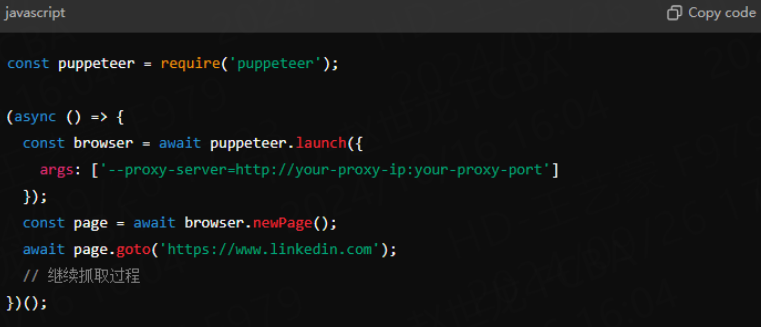The best proxy tool and configuration method for LinkedIn crawling
In the era of big data, data crawling has become an important tool for many companies and individuals to gain business insights. As the world's leading professional social platform, LinkedIn has a large amount of high-value user data. However, due to LinkedIn's strict restrictions on crawling behavior, direct access to data often encounters problems such as IP blocking. In order to avoid these troubles and crawl LinkedIn data efficiently, it is particularly important to use appropriate proxy tools and configuration methods. This article will introduce you to several proxy tools suitable for LinkedIn crawling, and explain in detail how to configure the proxy.
1. What is a proxy tool? Its role in LinkedIn crawling
A proxy tool acts as an intermediary server between the user and the target website, hiding the user's true identity through different IP addresses. For LinkedIn data crawling, the proxy can help users bypass the website's crawling detection and restrictions to ensure that the crawling process goes smoothly.
LinkedIn has strict anti-scraping mechanisms, such as limiting request frequency and detecting abnormal traffic. By using proxy tools, you can use multiple IP addresses to crawl at the same time to avoid being blocked. At the same time, the proxy can also simulate traffic from different regions to crawl data worldwide.
2. Recommended LinkedIn crawling proxy tools
PIAProxy
PiaProxy is the world's best socks5 commercial residential proxy, with more than 350 million overseas residential IPs, which can support HTTP (S) proxy and Socks5 proxy. For LinkedIn crawling, residential IP is a very ideal choice because it can provide high anonymity and reduce the risk of being detected.
Advantages:
More than 350 million residential proxies in more than 200 locations to choose from
Specified countries, states, cities, ISPs, accurate street-level IP screening
24-hour stable IP, real residential IP
ScraperAPI
ScraperAPI is a proxy service specifically for data crawling, which can automatically handle complex crawling problems, such as IP blocking, CAPTCHA, etc. It can provide an efficient IP rotation mechanism to ensure the stability and continuity of crawling.
Advantages:
Automatic IP rotation function
Easy to handle CAPTCHA and IP blocking
Easy to integrate with crawlers
3. How to configure proxy tools for LinkedIn data scraping
Step 1: Choose the right proxy type
When scraping LinkedIn data, it is recommended to use residential IP proxies, because residential IPs are closer to the access behavior of ordinary users and are less likely to attract LinkedIn's attention. Some proxy service providers such as Bright Data and Smartproxy provide stable residential IP resources.
Step 2: Set up the integration of crawlers and proxies
Depending on the crawler you use, the configuration method of the proxy may be different. Common crawlers such as Puppeteer and Selenium usually support setting proxies through the command line or code. The following is an example of Puppeteer's proxy settings:
![]()

Here, replace your-proxy-ip and your-proxy-port with the specific IP and port information you get from the proxy service provider.
Step 3: Rotate IP regularly to prevent IP blocking
LinkedIn is highly sensitive to repeated requests, so it is recommended to configure the proxy rotation function to prevent being blocked. Many proxy services, such as ScraperAPI, support automatic IP rotation. Users only need to enable the relevant function when making a request to ensure that each request is sent from a different IP.
Step 4: Set the request frequency to avoid excessive crawling
Although the proxy can hide your real IP, frequent requests may still attract LinkedIn's attention. To reduce the risk, it is recommended to set a reasonable crawling frequency to avoid triggering LinkedIn's crawling detection mechanism. Generally, a request frequency of a few seconds to tens of seconds is safer.
4. Risks and avoidance strategies of using proxy tools
Although proxy tools can greatly improve crawling efficiency, improper use may still bring risks. Common risks include IP blocking, request failure, and violation of the terms of use of the target website. To avoid these problems, you need to choose a reliable proxy service provider and set a reasonable crawling strategy.
Avoidance strategy:
Choose high-quality proxies: Avoid using low-quality, cheap proxy services, which usually provide unstable IP resources and easily lead to crawling failures or bans.
Reduce crawling frequency: Do not make requests too frequent to avoid triggering LinkedIn's anti-scraping mechanism.
Comply with the rules of the target website: When crawling data, be sure to comply with LinkedIn's terms of service to avoid malicious crawling and data abuse.
5. Conclusion
Using proxy tools to crawl LinkedIn data is a highly technical operation, but by choosing the right proxy service and configuration method, you can effectively avoid restrictions and quickly obtain target data. In the actual operation process, be sure to handle the proxy settings carefully, reasonably control the crawling frequency, and choose a reliable service provider to ensure the smooth progress of data crawling.



















































